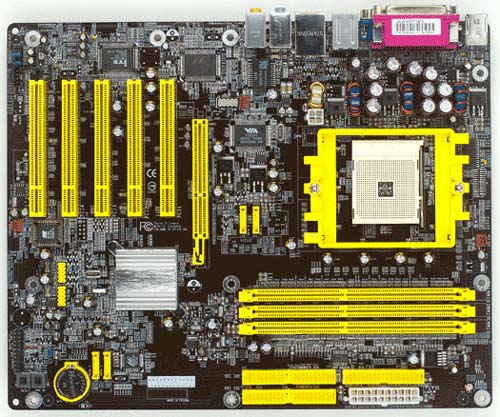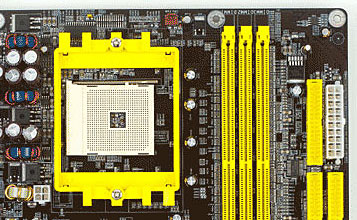DFI LANParty UT nF3-250Gb: Overclocker's Dream
by Wesley Fink on September 8, 2004 12:05 AM EST- Posted in
- Motherboards
Board Layout: DFI LANParty UT nF3 250Gb
DFI has never been afraid to use stand-out colors on their LANParty boards, and the black and yellow of the LANParty UT will certainly stand out in any side window case.
The basic layout of the DFI is excellent, with most everything in the best place in most case designs.

The ATX 20-pin and the 4-pin 12V connector are separated in the DFI, but the locations still work reasonably well. The bulky ATX connector is on our preferred far right edge on the upper half of the board. The 4-pin connector is on the opposite side of the CPU, at the very bottom edge of the CPU socket. The 20-pin ATX is clear of other connectors and should not interfere with air flow. The 4-pin requires a little more care with its near center board location, but the 4-pin is easier to route than the thick ATX cable.

The CPU socket is in the top center of the board. PCI slots are below the socket and memory is to the right of the CPU. There is plenty of room around the Socket 754, so just about any heatsink/fan should work fine. We had no problems mounting a Zalman 7000 on the DFI.

The IDE connectors are in our preferred upper right edge of the motherboard, where they rarely interfere with other connectors. SATA connectors mirror the nF3-250 Reference Board in that 2 are between the AGP slot and the CPU, and 2 are near the lower right edge of the board. The arrangement looks worse than it functions, since the SATA cables are very small. However, SATA connectors are still far too fragile for our liking and anything that gets them away from "high-traffic" areas of the board is preferred. You need to be extremely careful changing a video card or replacing a HSF so that you don't push and break off the SATA connectors between the AGP and CPU. The other 2 SATA connectors are better located near the right edge so that they are out of harm's way.

The floppy connector is ideally located on the upper right edge of the board. It is good to see DFI paying attention to the floppy port location, since many nF3-250 boards put the floppy at the bottom of the board - a difficult location for most full tower cases.

The LANParty UT has 5 PCI slots. The AGP slot uses the common "push to release" lever that works fine with most cards, but can be a real pain with very large top end cards like the nVidia 6800 Ultra. The headers are generally in out-of-the-way locations. However, if you need to use an audio cable with your optical drives, the location at the bottom of the board can be an impossible reach in some tower designs. Like the disappearing floppy, audio cables are rarely required any more, but if you need them, this location can be a challenge in some case designs.
A lot of thought went into the DFI nF3-250Gb board layout. While there are a few things that could be better, overall, the board was easy to install and set up. Most users will be very pleased with the layout.










54 Comments
View All Comments
alex1971 - Wednesday, September 8, 2004 - link
alex1971 - Wednesday, September 8, 2004 - link
I think its tested with Raid 3+4 that are the two native Ports directly at NF250GB.The Ports 1+2 are native also, but have to use an external PHY.
This Ports 1+2 are finished when HTT > 240 MHZ !!
Try it.....
Remeber: Main S-ATA Problems only at PORT 1+2 because of the PHY .....
Jeff7181 - Wednesday, September 8, 2004 - link
Glad I didn't buy a MSI K8N Neo Platinum yet... I'll wait for this board before I go A64. =)SLIM - Wednesday, September 8, 2004 - link
Great article man, but I almost blew by the part where you mentioned that the Far Cry and UT results were with a 9800pro vs 6800ultras. You might consider putting asterisk on those graphs and bold or highlight the huge difference in graphics cards.It might help those who prefer to only look at the pretty pictures.
SLIM
PS: I second the Iwill board review request.
SUOrangeman - Wednesday, September 8, 2004 - link
Review request: http://www.iwillusa.com/products/ProductDetail.asp...Although this is not a 754-pin mobo, the experience should be great nonetheless!
-SUO
at80eighty - Wednesday, September 8, 2004 - link
i second..umm...third...punko's Anantech's "Overclocking for Dummies" idea...i'd LOVE to dig into my rig...but it kinda scares me if i f*ckup : )
Myrandex - Wednesday, September 8, 2004 - link
I think the yellow looks cool, but a UV reactive plastic would have been cool along with it. This does seem a bit more of a 'budget' type board when compared to other LanParty series boards. I sure do like it a lot, and I have considered moving from my old MSI K8T Neo board to this one (so I am kinda happy about it being S754). I do wonder about the two SATA cables near the AGP socket, as they are extremely out of the way, and it brings more cable clutter to the center of the board.Wesley Fink - Wednesday, September 8, 2004 - link
#16 - The test bed had a MaXLine III 250GB SATA hard drive with 16MB of buffer. We first tested with the SATA on Channel 1 between the AGP slot and the CPU -- the plan was to see where SATA failed and then switch to IDE to find the top OC. When we reached DDR600 then DDR616 while running this SATA drive we saw no point in the IDE switch. This board is really stable in OC - even with SATA.rjm55 - Wednesday, September 8, 2004 - link
You say on page 6 that you ran the overclocking tests with a SATA hard drive. Can you please confirm that you did DDR616 running a SATA hard drive, because I've read that SATA drives can hold back overclocking.Avalon - Wednesday, September 8, 2004 - link
*drool*